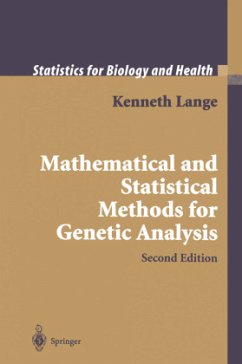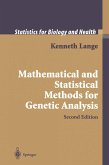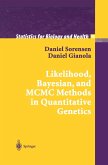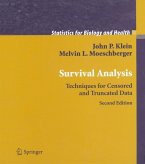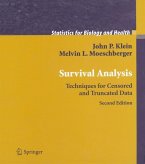During the past decade, geneticists have cloned scores of Mendelian disease genes and constructed a rough draft of the entire human genome. The unprecedented insights into human disease and evolution offered by mapping, cloning, and sequencing will transform medicine and agriculture. This revolution depends vitally on the contributions of applied mathematicians, statisticians, and computer scientists. Mathematical and Statistical Methods for Genetic Analysis is written to equip students in the mathematical sciences to understand and model the epidemiological and experimental data encountered in genetics research. Mathematical, statistical, and computational principles relevant to this task are developed hand in hand with applications to population genetics, gene mapping, risk prediction, testing of epidemiological hypotheses, molecular evolution, and DNA sequence analysis. Many specialized topics are covered that are currently accessible only in journal articles. This second edition expands the original edition by over 100 pages and includes new material on DNA sequence analysis, diffusion processes, binding domain identification, Bayesian estimation of haplotype frequencies, case-control association studies, the gamete competition model, QTL mapping and factor analysis, the Lander-Green-Kruglyak algorithm of pedigree analysis, and codon and rate variation models in molecular phylogeny. Sprinkled throughout the chapters are many new problems.
From the reviews of the second edition:
"This book is an excellent resource for statisticians and applied mathematicians seeking an overview of models and formalisms in use in a wide collection of generic analysis processes." Journal of the American Statistical Association, June 2005
"Genetics is a subject that has always attracted the attention of statisticians back to the time that Mendel did his discoveries. ... The current book realizes this and tries to provide a gentle introduction to a wide range of statistical topics in genetics. ... I highly recommend this book for Master's students wishing to see many interesting applications of statistics in genomics. On their way through this book, they will be rewarded with knowledge of a wide range of statistical topics." (Dr A. Di Bucchianico, Kwantitatieve Methoden, Vol. 72B38, 2006)
"More than 100 pages have been added in this Second Edition ... . The strength of this book is that it provides the foundations and rigorous details of mathematical and statistical methodologies that are applied in genetics. ... A nice feature of this book is that there are about a dozen problems for solution at the end of each chapter, which will be useful for the serious reader." (Partha P. Majumder, Sankhya, Vol. 65 (3), 2003)
"This monograph is the second edition of Lange's 1997 work, increased by more than 100 pages. ... Several chapters of the first edition have been supplemented by new material. ... The book is intended for readers with basic knowledge in theoretical statistics, calculus and linear algebra. ... Summarizing, this monograph can be recommended to all who want to connect their knowledge of mathematical statistics and genetics and learn about the statistical solutions ... for genetical research problems." (C. Becker, Metrika, September, 2003)
"The second edition of this book by Ken Lange continues to present a very broad coverage of mathematical andstatistical methods in the analysis of genetic data. The text has something to offer both mathematicians already experienced in genetics, as well as those with little experience in the area ... . The book allows readers to appreciate the enormous contribution that Lange has made to the area and will hopefully inspire them (in Lange's words) 'to create new models and methods for analyzing genetic data'." (Lyle C. Gurrin and John L. Hopper, Statistics in Medicine, Vol. 23, 2004)
"This is an excellent book written in the same crisp and clear style as the first edition. It has enough in detail of the underpinning genetics to allow the mathematicians and statisticians to gain an understanding sufficient to see the challenge and richness of the area. ... It is both a useful reference source and a suitable introduction ... . This is a book I am happy to recommend highly, and I look forward to the third edition in a few years time." (C Cannings, Heredity, Issue 92, 2004)
"The revolution in molecular genetics during the past decade has led to an avalanche of new data whose analysis requires increasingly sophisticated mathematical, statistical and computational methods. This book provides an up-to-date introduction to several of the most important mathematical and statistical methods developed for this purpose. ... this is a major text that will be most useful for researchers and students of mathematics or statistics interested or engaged in the analysis of genetic data." (R. Bürger, Monatshefte für Mathematik, Vol. 139 (3), 2003)
"Mathematical and Statistical Methods for Genetic Analysis is written to equip students in the mathematical sciences to understand and model the epidemiological and experimental data encountered in genetics research. ... Mathematical, statistical, and computational principles relevant to this task are developed ... . Many specialized topics are covered that are currently accessible only in journal articles. This secondedition expands the original edition by over 100 pages and includes new material ... ." (Zentralblatt für Didaktik, June, 2002)
"The first edition of this book appeared in 1997 ... and filled an important gap by covering in a unified setting topics dispersed in the research literature. This second edition is considerably larger, updating the first edition and adding some new topics. There are two new chapters ... . Several new sections have also been added to existing chapters ... ." (Carlos A. Braumann, Zentralblatt MATH, Vol. 991 (16), 2002)
"This book is an excellent resource for statisticians and applied mathematicians seeking an overview of models and formalisms in use in a wide collection of generic analysis processes." Journal of the American Statistical Association, June 2005
"Genetics is a subject that has always attracted the attention of statisticians back to the time that Mendel did his discoveries. ... The current book realizes this and tries to provide a gentle introduction to a wide range of statistical topics in genetics. ... I highly recommend this book for Master's students wishing to see many interesting applications of statistics in genomics. On their way through this book, they will be rewarded with knowledge of a wide range of statistical topics." (Dr A. Di Bucchianico, Kwantitatieve Methoden, Vol. 72B38, 2006)
"More than 100 pages have been added in this Second Edition ... . The strength of this book is that it provides the foundations and rigorous details of mathematical and statistical methodologies that are applied in genetics. ... A nice feature of this book is that there are about a dozen problems for solution at the end of each chapter, which will be useful for the serious reader." (Partha P. Majumder, Sankhya, Vol. 65 (3), 2003)
"This monograph is the second edition of Lange's 1997 work, increased by more than 100 pages. ... Several chapters of the first edition have been supplemented by new material. ... The book is intended for readers with basic knowledge in theoretical statistics, calculus and linear algebra. ... Summarizing, this monograph can be recommended to all who want to connect their knowledge of mathematical statistics and genetics and learn about the statistical solutions ... for genetical research problems." (C. Becker, Metrika, September, 2003)
"The second edition of this book by Ken Lange continues to present a very broad coverage of mathematical andstatistical methods in the analysis of genetic data. The text has something to offer both mathematicians already experienced in genetics, as well as those with little experience in the area ... . The book allows readers to appreciate the enormous contribution that Lange has made to the area and will hopefully inspire them (in Lange's words) 'to create new models and methods for analyzing genetic data'." (Lyle C. Gurrin and John L. Hopper, Statistics in Medicine, Vol. 23, 2004)
"This is an excellent book written in the same crisp and clear style as the first edition. It has enough in detail of the underpinning genetics to allow the mathematicians and statisticians to gain an understanding sufficient to see the challenge and richness of the area. ... It is both a useful reference source and a suitable introduction ... . This is a book I am happy to recommend highly, and I look forward to the third edition in a few years time." (C Cannings, Heredity, Issue 92, 2004)
"The revolution in molecular genetics during the past decade has led to an avalanche of new data whose analysis requires increasingly sophisticated mathematical, statistical and computational methods. This book provides an up-to-date introduction to several of the most important mathematical and statistical methods developed for this purpose. ... this is a major text that will be most useful for researchers and students of mathematics or statistics interested or engaged in the analysis of genetic data." (R. Bürger, Monatshefte für Mathematik, Vol. 139 (3), 2003)
"Mathematical and Statistical Methods for Genetic Analysis is written to equip students in the mathematical sciences to understand and model the epidemiological and experimental data encountered in genetics research. ... Mathematical, statistical, and computational principles relevant to this task are developed ... . Many specialized topics are covered that are currently accessible only in journal articles. This secondedition expands the original edition by over 100 pages and includes new material ... ." (Zentralblatt für Didaktik, June, 2002)
"The first edition of this book appeared in 1997 ... and filled an important gap by covering in a unified setting topics dispersed in the research literature. This second edition is considerably larger, updating the first edition and adding some new topics. There are two new chapters ... . Several new sections have also been added to existing chapters ... ." (Carlos A. Braumann, Zentralblatt MATH, Vol. 991 (16), 2002)

